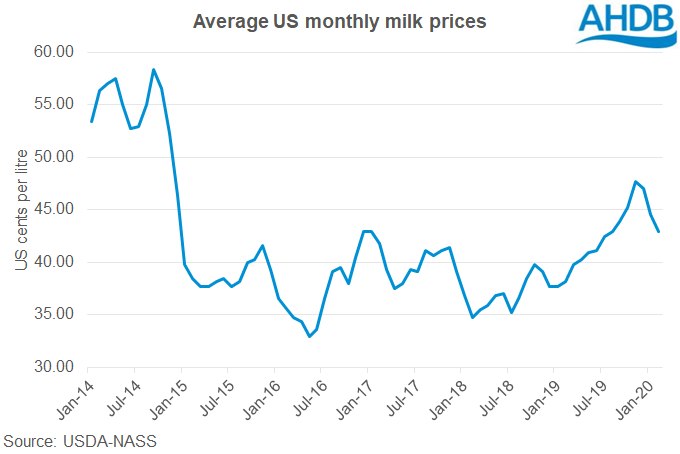Challenges in supply chain force US farmers to dump milk
Wednesday, 15 April 2020
By Felicity Rusk
Just as in the UK, across the pond, some US dairy producers are being left with no option but to dispose of milk on-farm, due to challenges in the supply chain. This has put further downwards pressure on prices.
While it is too early to quantify how much milk is being disposed of, the International Dairy Foods Association (IDFA) suggest that supply exceeds demand by at least 10% in the US. This will only be exacerbated as production rises seasonally.
The mass closures of restaurants and schools meant that demand from the foodservice sector dissipated. As such, re-routing supply chains towards retail created logistical and packaging challenges for processing plants. Additionally, reports have suggested that companies that haul products are struggling to source enough drivers. Finally, exports to many major destinations are reportedly down, as the foodservice sector shuts down globally.
Demand at a retail level has picked up. In the week ended March 21, retail sales of milk rose by 53% on the year, according to Nielson data. Other dairy products also benefitted, with butter and cheese sales up 127% and 84% respectively. However, this uplift in demand has not been enough to compensate for the loss from the foodservice sector.
The shutdown of the foodservice sector and the increased availability of milk has put significant pressure on prices. Chicago (CME) futures prices for class III milk* on the April 2020 contract reached a low of $13.56/100lbs (30.8 cents/litre) on 9 April. This is 21% less than where the contract started the year at. This pressure has also been felt in wholesale markets and at the farmgate.

The United States Department of Agricultural (USDA) has revealed a $15 billion assistance package to support US farmers through the COVID-19 pandemic. Details on how the funding will be distributed have not yet been announced.
*Class III milk is used in the manufacture of cream cheese and other spreadable cheeses, and hard cheese of types that may be shredded, grated, or crumbled. It also includes plastic cream, anhydrous milkfat, and butteroil.
Sign up to receive the latest information from AHDB.
While AHDB seeks to ensure that the information contained on this webpage is accurate at the time of publication, no warranty is given in respect of the information and data provided. You are responsible for how you use the information. To the maximum extent permitted by law, AHDB accepts no liability for loss, damage or injury howsoever caused or suffered (including that caused by negligence) directly or indirectly in relation to the information or data provided in this publication.
All intellectual property rights in the information and data on this webpage belong to or are licensed by AHDB. You are authorised to use such information for your internal business purposes only and you must not provide this information to any other third parties, including further publication of the information, or for commercial gain in any way whatsoever without the prior written permission of AHDB for each third party disclosure, publication or commercial arrangement. For more information, please see our Terms of Use and Privacy Notice or contact the Director of Corporate Affairs at info@ahdb.org.uk © Agriculture and Horticulture Development Board. All rights reserved.

